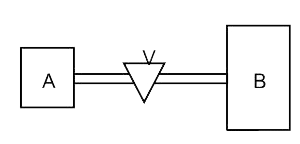A gas at 300 K has pressure 4×10−10N/m2. IF k=1.38×10−23J/K, the number of molecule/cm3 is of the order of
105
10
107
1011
The correct Answer is:A
To solve the problem of finding the number of molecules per cubic centimeter for the given gas, we can use the ideal gas equation in conjunction with the Boltzmann constant. Here’s a step-by-step breakdown of the solution:
1. Identify the Given Values:
- Temperature (T) = 300 K
- Pressure (P) = 4×10−10N/m2
- Boltzmann constant (k) = 1.38×10−23J/K
2. Use the Ideal Gas Law:
The ideal gas law can be expressed in terms of the number of molecules:
PV=NkT
where N is the number of molecules, P is the pressure, V is the volume, k is the Boltzmann constant, and T is the temperature.
3. Rearranging the Equation:
To find the number of molecules per unit volume (molecules per cubic meter), we can rearrange the equation:
N=PVkT
Therefore, the number of molecules per unit volume (molecules/m³) is:
n=NV=PkT
4. Substituting the Values:
Substitute the values into the equation:
n=4×10−10(1.38×10−23)(300)
5. Calculating the Denominator:
First, calculate kT:
kT=(1.38×10−23)(300)=4.14×10−21J
6. Calculating the Number of Molecules per Cubic Meter:
Now substitute kT back into the equation for n:
n=4×10−104.14×10−21≈9.66×1010molecules/m3
7. Convert to Molecules per Cubic Centimeter:
Since 1m3=106cm3, we convert:
n≈9.66×1010106≈9.66×104molecules/cm3
8. Final Answer:
The number of molecules per cubic centimeter is of the order of 105.
- Temperature (T) = 300 K
- Pressure (P) = 4×10−10N/m2
- Boltzmann constant (k) = 1.38×10−23J/K
The ideal gas law can be expressed in terms of the number of molecules:
PV=NkT
where N is the number of molecules, P is the pressure, V is the volume, k is the Boltzmann constant, and T is the temperature.
To find the number of molecules per unit volume (molecules per cubic meter), we can rearrange the equation:
N=PVkT
Therefore, the number of molecules per unit volume (molecules/m³) is:
n=NV=PkT
Substitute the values into the equation:
n=4×10−10(1.38×10−23)(300)
First, calculate kT:
kT=(1.38×10−23)(300)=4.14×10−21J
Now substitute kT back into the equation for n:
n=4×10−104.14×10−21≈9.66×1010molecules/m3
Since 1m3=106cm3, we convert:
n≈9.66×1010106≈9.66×104molecules/cm3
The number of molecules per cubic centimeter is of the order of 105.
Topper's Solved these Questions
- BEHAVIOUR OF PERFECT GAS & KINETIC THEORYBOOK - PRADEEPCHAPTER - BEHAVIOUR OF PERFECT GAS & KINETIC THEORYEXERCISE - Multiple choice questions-II
8 Videos
- BEHAVIOUR OF PERFECT GAS & KINETIC THEORYBOOK - PRADEEPCHAPTER - BEHAVIOUR OF PERFECT GAS & KINETIC THEORYEXERCISE - Multiple choice questions-III
12 Videos
- BEHAVIOUR OF PERFECT GAS & KINETIC THEORYBOOK - PRADEEPCHAPTER - BEHAVIOUR OF PERFECT GAS & KINETIC THEORYEXERCISE - Problems for practice
47 Videos
- GRAVIATIONBOOK - PRADEEPCHAPTER - GRAVIATIONEXERCISE - Assertion-Reason Type Questions
19 Videos
Similar Questions
Calculate the KE per molecule and also rms velocity of a gas at 127∘C. Given k=1.38×10−23Jmolecule−1K−1 and mass of each molecule =6.4×10−27kg.
View SolutionAn electric bulb of volume 300 cm3 is sealed at temperature 300 K and pressure 10−4 mm of mercury. Find the number of air molecules in the bulb.
(Given, σ=13.6×103kgm−3andkB=1.38×10−23jK−1)
View Solution
Knowledge Check
The number of gas molecules striking per second per square meter of the top surface of a table placed in a room at 20∘C and 1 atmospheric pressure is of the order of (kB=1.4×10−23 J/K, and the average mass of an air molecules is 5×10−27kg)
A1027B1023C1025D1029The rate constant of a reaction at 300 K is1.6×10−3sec−1 and at 310K it is 3.2×10−3sec−1 the activation energy of the reaction approximately in kcals is
A41609B20-25C30-40D40-50One gram molecule of nitrogen occupies 2×104cm3 at a pressure of 106 dynecm=−2.
Given :NA=6×1023. Which of the following is correct ?AThe value of kT is 13×10−13ergBThe value of KT is 14×10−−13 ergCMena kinetic energy per molecule is 5×10−14ergDMean kinetic energy per molecule is 9.8 erg
The peressure exerected by a certain mass of enclosed gas at 300 K is 5×104N/m2 .what will be the pressure exerted by the has ay 600 K if the volume of the gas is kept constant ?
View SolutionEstimate the average energy of a helium atom at (i) room temperature (27∘C) (ii) the temperature on the surface of the sun (6000K) and (iii) the temperature of 107K. Given kB=1.38×10−23Jmolecule−1K−1
View SolutionCalculate the viscosity of molecular oxygen in Pa s at 273 K and 1 bar. Given that molecular diameter =0.36×10−9m,
k=1.38×10−23JK−1 and Av. const. =6.022×1023
View SolutionA certain ideal gas has a temperature 300 K and a pressure 5.0×104 Pa. The molecules have a mean free path of 4.0×10−7m. If the temperature is raised to 350 K and the pressure is reduced to 1.0×104 Pa the mean free path is then
View SolutionContainer A holds an ideal gas at a pressure 1×105 Pa and at 300 K. Container B whose volume is 4 times the volume of A has the same ideal gas at 400 K and at a pressure of 5×105

Before the valve V is opened, the ratio of number of moles of gas in A and B is :
View Solution